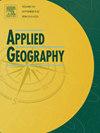A geospatial perspective on electrification strategy in urbanizing africa
IF 4
2区 地球科学
Q1 GEOGRAPHY
引用次数: 0
Abstract
Efforts to achieve Sustainable Development Goal (SDG) 7, to ensure modern energy for all, have largely followed models of rural electrification premised on extending the provision of electricity to remote, low-income populations. Yet, urbanization in Africa has produced complex and densifying human settlement patterns with diverse economic and energetic needs. Much of the body of work supporting SDG 7 relies on a binary rural-urban categorization and has yet to engage critically with the increasing spatial, demographic, and economic heterogeneity of these spaces. This analysis uses geospatial techniques to evaluate the distribution of the unelectrified in sub-Saharan Africa along a 30-category spatial framework which describes space along a rural-urban continuum. Our results highlight large concentrations of unelectrified people in the peripheries of small to medium cities, which themselves are often poorly electrified. More sophisticated ways of understanding the spatiality of electrification can provide strategic insights on how we assess the needs and barriers to access for diverse communities, select and innovate appropriate technologies and solutions, and define effective jurisdictions for government institutions.
非洲城市化中电气化战略的地理空间视角
为实现可持续发展目标7(确保人人享有现代能源)所做的努力在很大程度上遵循了农村电气化模式,其前提是向偏远低收入人口提供电力。然而,非洲的城市化产生了复杂和密集的人类住区模式,具有不同的经济和能源需求。支持可持续发展目标7的大部分工作都依赖于二元城乡分类,尚未认真考虑这些空间日益增长的空间、人口和经济异质性。该分析使用地理空间技术,沿着一个描述城乡连续体空间的30类空间框架,评估撒哈拉以南非洲地区未通电人口的分布。我们的研究结果强调了大量未通电人口集中在中小城市的外围地区,而这些城市本身的电气化程度往往很低。理解电气化的空间性的更复杂的方法可以为我们如何评估不同社区的需求和准入障碍,选择和创新适当的技术和解决方案,以及为政府机构定义有效的管辖权提供战略见解。
本文章由计算机程序翻译,如有差异,请以英文原文为准。
求助全文
约1分钟内获得全文
求助全文
来源期刊

Applied Geography
GEOGRAPHY-
CiteScore
8.00
自引率
2.00%
发文量
134
期刊介绍:
Applied Geography is a journal devoted to the publication of research which utilizes geographic approaches (human, physical, nature-society and GIScience) to resolve human problems that have a spatial dimension. These problems may be related to the assessment, management and allocation of the world physical and/or human resources. The underlying rationale of the journal is that only through a clear understanding of the relevant societal, physical, and coupled natural-humans systems can we resolve such problems. Papers are invited on any theme involving the application of geographical theory and methodology in the resolution of human problems.
 求助内容:
求助内容: 应助结果提醒方式:
应助结果提醒方式:


